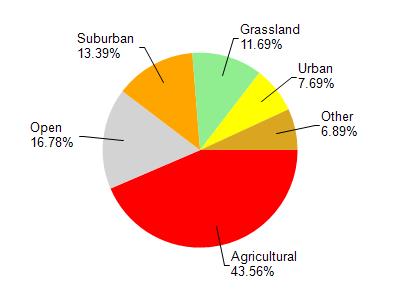Winnebago
No
No
No
Fish and Aquatic Life
Overview
The lower half mile of Daggets Creek is a dredged channel entering Lake Butte des Morts. Soil loss along Daggets Creek averages more than 3 T/A/YR with three barnyard/feedlot operations ranked critical and two ranked high for their NPS pollution hazard.
Date 1996
Author Cheryl Bougie
Historical Description
Daggets Creek, T18N, R16E, Section 30 (2), Area = 4.5 acres, Length = 3.1 miles, Gradient = 10.9 feet/mile.
This stream, tributary to Lake Butte des Morts, contains turbid, hard water. Except for the lower
half mile, the stream is intermittent and to a large extent ditched. The lower half mile is a dredged
channel some 50 feet wide and three feet deep. Lands adjacent to this channel have been
subdivided. Watershed land use is largely agricultural. Public access is provided by one federal
highway, one county highway, and one town road.
From: 1975. Surface Water Resources of Winnebago County: Lake and Stream Classification Project,
Wisconsin Department of Natural Resources, Madison, WI.
Date 1975
Author Surface Water Inventory Of Wisconsin
General Condition
This water was assessed during the 2016 listing cycle; total phosphorus and biological sample data clearly met 2016 WisCALM listing thresholds for the Fish and Aquatic Life use.
Date 2015
Author Wdnr Water Quality
Condition
Wisconsin has over 84,000 miles of streams, 15,000 lakes and milllions of acres of wetlands. Assessing the condition of this vast amount of water is challenging. The state's water monitoring program uses a media-based, cross-program approach to analyze water condition. An updated monitoring strategy (2015-2020) is now available. Compliance with Clean Water Act fishable, swimmable standards are located in the Executive Summary of Water Condition in 2018. See also the 'monitoring and projects' tab.
Reports
Recommendations
Land Acquisition
The Butte des Morts Cohnservation Club will acquire approximately 1,183 acres of land, including 13,000 feet of shoreline, situated on Lake Butte des Morts in Winnebago County to protect Lake Butte des Morts, and its fish and wildlife habitat.
Management Goals
Wisconsin's Water Quality Standards provide qualitative and quantitative goals for waters that are protective of Fishable, Swimmable conditions [Learn more]. Waters that do not meet water quality standards are considered impaired and restoration actions are planned and carried out until the water is once again fishable and swimmable
Management goals can include creation or implementation of a Total Maximum Daily Load analysis, a Nine Key Element Plan, or other restoration work, education and outreach and more. If specific recommendations exist for this water, they will be displayed below online.
Monitoring
Monitoring the condition of a river, stream, or lake includes gathering physical, chemical, biological, and habitat data. Comprehensive studies often gather all these parameters in great detail, while lighter assessment events will involve sampling physical, chemical and biological data such as macroinvertebrates. Aquatic macroinvertebrates and fish communities integrate watershed or catchment condition, providing great insight into overall ecosystem health. Chemical and habitat parameters tell researchers more about human induced problems including contaminated runoff, point source dischargers, or habitat issues that foster or limit the potential of aquatic communities to thrive in a given area. Wisconsin's Water Monitoring Strategy was recenty updated.
Grants and Management Projects
Monitoring Projects
| WBIC | Official Waterbody Name | Station ID | Station Name | Earliest Fieldwork Date | Latest Fieldwork Date | View Station | View Data |
|---|
| 140200 | Daggets Creek | 713260 | Daggets Creek - Brooks Rd | 5/5/1980 | 8/15/2020 | Map | Data |
|

Watershed Characteristics
Daggets Creek is located in the Lake Butte Des Mortes watershed which is 79.65 mi². Land use in the watershed is primarily agricultural (43.60%), open (16.80%) and a mix of suburban (13.40%) and other uses (26.30%). This watershed has 128.44 stream miles, 85.47 lake acres and 1,498.62 wetland acres.
Nonpoint Source Characteristics
This watershed is ranked High for runoff impacts on streams, Not Available for runoff impacts on lakes and High for runoff impacts on groundwater and therefore has an overall rank of High. This value can be used in ranking the watershed or individual waterbodies for grant funding under state and county programs.However, all waters are affected by diffuse pollutant sources regardless of initial water quality. Applications for specific runoff projects under state or county grant programs may be pursued. For more information, go to surface water program grants.